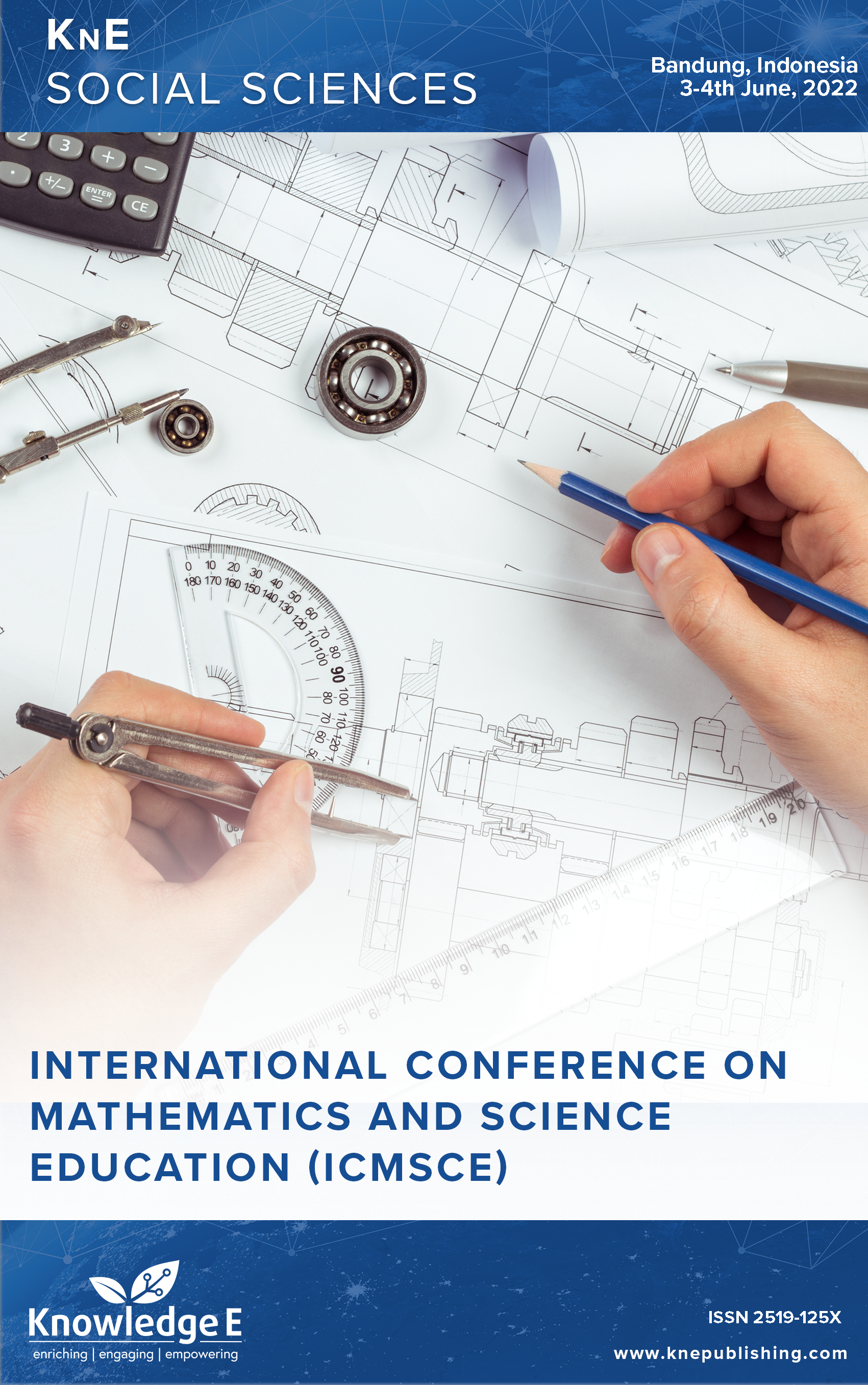Development of Teaching Materials and Concept Maps About the Relationship Between Sustainability and Chitosan for Water Treatment: Qualitative Content Analysis
DOI:
https://doi.org/10.18502/kss.v9i13.15917Abstract
Chitosan is formed by deacetylation of chitin using strong alkali at high temperatures. The content of the active amine groups in chitosan is widely used as an alternative natural coagulant that is environmentally friendly. So, it can be included in learning materials about the concept of sustainability. This study aimed to produce concept maps and Teaching Learning Sequences (TLS) based on scientists’ conceptions of sustainability on the topic of water treatment using natural coagulants. The method used in this research was qualitative content analysis. The research instruments included content analysis formats and sustainability aspects. The content analysis process included literature collection, descriptive analysis, category selection, and material evaluation with didactic aspects. This research produced concept maps and TLS that described the relationship between water treatment using natural coagulants and colloid content. Additionally, TLS related to sustainability education in the form of learning about water treatment using natural coagulants from chitosan was also developed. The concept map and TLS that have been compiled show the relationship between mapping aspects of scientific literacy and environmentally friendly water treatment using natural coagulants. The research results can be used as a basis for developing teaching materials and didactic designs.
Keywords: concept maps, sustainability, chitosan
References
Rauch F. Education for sustainable development and chemistry education. Worldwide trends in green chemistry education. 2015. p. 16–26. DOI: https://doi.org/10.1039/9781782621942-00016
Mochtar NE, Gasim H, Hendarman NI, Wijiasih A, Suryana C. Pendidikan untuk pembangunan berkelanjutan di indonesia implementasi dan kisah sukses. Komisi Nasional Indonesia untuk UNESCO (KNIU) Kementerian Pendidikan dan Kebudayaan. Jakarta; 2015.
Listiawati N. Kondisi lima taman bacaan masyarakat (TBM) di Tangerang dan Bandung dalam upaya meningkatkan minat baca masyarakat. Jurnal Pendidikan dan Kebudayaan. 2010;16(1):13-24. https://doi.org/10.24832/jpnk.v16i1.427. DOI: https://doi.org/10.24832/jpnk.v16i1.427
Walker JP, Sampson V, Southerland S, Enderle PJ. Using the laboratory to engage all students in science practices. Chem Educ Res Pract. 2016;17(4):1098–113. DOI: https://doi.org/10.1039/C6RP00093B
Mahaffy PG, Matlin SA, Whalen JM, Holme TA. Integrating the molecular basis of sustainability into general chemistry through systems thinking. J Chem Educ. 2019;96(12):2730–41. DOI: https://doi.org/10.1021/acs.jchemed.9b00390
Samet C, Valiyaveettil S. Fruit and vegetable peels as efficient renewable adsorbents for removal of pollutants from water: a research experience for general chemistry students. J Chem Educ. 2018;95(8):1354–8. DOI: https://doi.org/10.1021/acs.jchemed.8b00240
Ang WL, Mohammad AW. State of the art and sustainability of natural coagulants in water and wastewater treatment. J Clean Prod. 2020;262:121267. DOI: https://doi.org/10.1016/j.jclepro.2020.121267
Verma AK, Dash RR, Bhunia P. A review on chemical coagulation/flocculation technologies for removal of colour from textile wastewaters. J Environ Manage. 2012 Jan;93(1):154–68. DOI: https://doi.org/10.1016/j.jenvman.2011.09.012
Wang J, Zhuang S. Chitosan-based materials: preparation, modification and application. J Clean Prod. 2022;355:131825. DOI: https://doi.org/10.1016/j.jclepro.2022.131825
Momeni MM, Kahforoushan D, Abbasi F, Ghanbarian S. Using Chitosan/CHPATC as coagulant to remove color and turbidity of industrial wastewater: optimization through RSM design. J Environ Manage. 2018 Apr;211:347–55. DOI: https://doi.org/10.1016/j.jenvman.2018.01.031
Risopoulos-Pichler F, Daghofer F, Steiner G. Competences for solving complex problems: a cross-sectional survey on higher education for sustainability learning and transdisciplinarity. Sustainability (Basel). 2020;12(15):6016. DOI: https://doi.org/10.3390/su12156016
Hernández-Barco M, Sánchez-Martín J, Blanco-Salas J, Ruiz-Téllez T. Teaching down to earth—service-learning methodology for science education and sustainability at the university level: a practical approach. Sustainability (Basel). 2020;12(2):542. DOI: https://doi.org/10.3390/su12020542
Sáez de Cámara E, Fernández I, Castillo-Eguskitza N; The Case Study of the University of the Basque Country. A holistic approach to integrate and evaluate sustainable development in higher education. The case study of the University of the Basque Country. Sustainability (Basel). 2021;13(1):392. DOI: https://doi.org/10.3390/su13010392
Badea L, ?erban-Oprescu GL, Dedu S, Piro?ca GI. The impact of education for sustainable development on romanian economics and business students’ behavior. Sustainability (Basel). 2020;12(19):8169. DOI: https://doi.org/10.3390/su12198169
Mayring P. “Qualitative content analysis: theoretical foundation, basic procedures and software solution.,” p. 2014. DOI: https://doi.org/10.1007/978-94-017-9181-6_13
Seuring S, Müller M, Westhaus M, Morana R. Conducting a literature review— the example of sustainability in supply chains. Research methodologies in supply chain management: in Collaboration with Magnus Westhaus. pp. 91–106, 2005. https://doi.org/10.1007/3-7908-1636-1_7. DOI: https://doi.org/10.1007/3-7908-1636-1_7
Kilic Z. Water pollution: causes, negative effects and prevention methods. Istanbul Sabahattin Zaim Üniversitesi Fen Bilimleri Enstitüsü Dergisi. 2021;3(2):129-132. DOI: https://doi.org/10.47769/izufbed.862679
Omer NH. Water quality parameters, water quality—science, assessments and policy. Kevin Summers, IntechOpen; 2019.
Sun Y, Zhou S, Chiang PC, Shah KJ. Evaluation and optimization of enhanced coagulation process. Water-Energy Nexus. 2019;2(1):25–36. DOI: https://doi.org/10.1016/j.wen.2020.01.001
Dayarathne HN, Angove MJ, Aryal R, Abuel-Naga H, Mainali B. Removal of natural organic matter from source water: review on coagulants, dual coagulation, alternative coagulants, and mechanisms. J Water Process Eng. 2021;40:101820. DOI: https://doi.org/10.1016/j.jwpe.2020.101820
Bratby J. Coagulation and flocculation. Uplands: Croydon, England; 1980.
Ang WL, Mohammad AW, Benamor A, Hilal N. Chitosan as natural coagulant in hybrid coagulation-nanofiltration membrane process for water treatment. J Environ Chem Eng. 2016;4(4):4857–62. DOI: https://doi.org/10.1016/j.jece.2016.03.029
Sciban M, Klašnja M, Antov M, Skrbic B. Removal of water turbidity by natural coagulants obtained from chestnut and acorn. Bioresour Technol. 2009 Dec;100(24):6639–43. DOI: https://doi.org/10.1016/j.biortech.2009.06.047
Ghernaout D. Water treatment coagulation: dares and trends. OAlib. 2020;7(8):1–18. DOI: https://doi.org/10.4236/oalib.1106636
Altaher H. The use of chitosan as a coagulant in the pre-treatment of turbid sea water. J Hazard Mater. 2012 Sep;233-234:97–102. DOI: https://doi.org/10.1016/j.jhazmat.2012.06.061
Iber BT, Okomoda VT, Rozaimah SA, Kasan NA. Eco-friendly approaches to aquaculture wastewater treatment: assessment of natural coagulants vis-a-vis chitosan. Bioresour Technol Rep. 2021;15:100702. DOI: https://doi.org/10.1016/j.biteb.2021.100702

